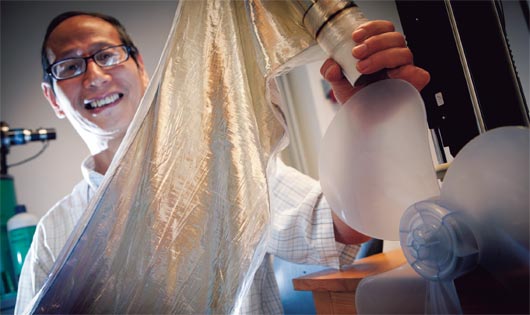New renewable energy
New elastic materials that can generate electricity may help make wave power cheaper to develop.
At first glance, the thin, almost silken material in Professor Kesheng Wang’s hands looks like stretchy plastic food wrap that has been coated with a fine layer of shiny aluminium. The material is called a dieletric electro-active polymer, or DEAP, and one of its most common uses is to transform electricity into movement – like an artificial muscle.
But Wang, a professor in NTNU’s Department of Production and Quality Engineering and head of the Knowledge Discovery Laboratory, wants to use the material in a completely opposite way. Instead of transforming electricity into movement, Wang wants to use the polymer to turn movement – specifically the long amplitude motion of waves – into electricity.
Wave energy made easier
“A wave energy generator transforms mechanical energy– movement – into electricity. But it involves lots of big mechanical parts,” the professor says. “If we can use this polymer it will be much simpler, lighter and easier to build wave energy generators.”
Although a number of different kinds of DEAP are available on the market, Wang is most interested in a type patented by a Danish company called DanFoss. When Wang first found the DanFoss DEAP, he wasn’t thinking he would develop a new approach to wave energy machines. Instead, his search was motivated by one of his many research interests– making robots work.
The DEAP elastic material is coated on both sides with a metallic substance. The coating serves as electrodes. When an electric current is applied to the electrodes, the elastic material expands, and when the current is turned off, it contracts. The expansion and contraction mimics the way real muscles work and could be used in robots to reduce the size, weight and complexity of their joints, Wang says.
From movement to electricity
But the magic of the material is that when you physically stretch it and then let it relax, the electrodes generate an electric current. By creating layers of DEAP in tightly packed rows, like curtains hanging in parallel, and clamping them on either end, the DEAP can be stretched and relaxed by the movement of a wave pushing on a paddle or other form of resistance. The movement thus generates electricity.
Wang has already built a small prototype of his wave energy machine using the DanFoss DEAP, and is now searching for research partners to build a larger prototype. “I call it ‘new’ renewable energy,” he says of the machine, because it uses new ‘smart materials’ to generate electricity from a conventional source of renewable energy.
Nancy Bazilchuk


